Untargeted Metabolomics Reveals the Effect of Carbon Dots on Improving the Shelf Life of Postharvest Goji Berries (Lycium barbarum L.)
Abstract
1. Introduction
2. Materials and Methods
2.1. Plant Material
2.2. Preparation of Carbon Dots
2.3. Photodynamic Treatment of Fresh Lycium barbarum Fruit
2.4. Determination of Decay Rate
2.5. Metabolomic Profiling of Fresh Lycium barbarum Fruit
2.5.1. Experimental Workflow
2.5.2. Sample Information
2.5.3. Metabolite Extraction and QC Preparation
2.6. Liquid Chromatography–Mass Spectrometry Analysis
2.6.1. Liquid Phase Conditions
2.6.2. Mass Spectrum Conditions
2.7. Data Processing and Analysis Methods
3. Results and Discussion
3.1. Changes in the Decay Rate and Apparent Changes in Fresh Fruit Wolfberry During Storage
3.2. QC-Based Total-Ion-Current Chromatogram Reproducibility
3.3. Metabolite Clustering and Quality-Assurance Validation of QC Samples
3.4. Metabolite Identification and Annotation
3.4.1. Identification of Metabolites
3.4.2. Metabolite Identification and KEGG Annotation
3.5. PLS-DA Model and Score Analysis Between Groups
3.6. PCA Between Groups and Analysis of Major Differential Metabolites
3.7. Total Metabolite Analysis of CDs-PDT-Treated Wolfberry Fruits
3.8. Temporal Profiling of Key Differential Metabolites Across T9 vs. CK9, T12 vs. CK12, and T15 vs. CK15
3.9. KEGG-Based Metabolic Pathway Enrichment of T9 vs. CK9, T12 vs. CK12, and T15 vs. CK15
3.10. Analysis of KEGG Metabolic Network
4. Conclusions
Supplementary Materials
Author Contributions
Funding
Institutional Review Board Statement
Informed Consent Statement
Data Availability Statement
Conflicts of Interest
References
- Ma, R.H.; Zhang, X.X.; Thakur, K.; Zhang, J.G.; Wei, Z.J. Research progress of Lycium barbarum L. as functional food: Phytochemical composition and health benefits. Curr. Opin. Food Sci. 2022, 47, 100871. [Google Scholar] [CrossRef]
- Wang, W.; Ni, Z.J.; Song, C.B.; Ma, W.P.; Cao, S.Q.; Wei, Z.J. Hydrogen sulfide treatment improves quality attributes via regulating the antioxidant system in goji berry (Lycium barbarum L.). Food Chem. 2023, 405, 134858. [Google Scholar] [CrossRef]
- Amagase, H.; Farnsworth, N.R. A review of botanical characteristics, phytochemistry, clinical relevance in efficacy and safety of Lycium barbarum fruit (Goji). Food Res. Int. 2011, 44, 1702–1717. [Google Scholar] [CrossRef]
- Potterat, O. Goji (Lycium barbarum and L. chinense): Phytochemistry, pharmacology and safety in the perspective of traditional uses and recent popularity. Planta Med. 2010, 76, 7–19. [Google Scholar] [CrossRef] [PubMed]
- Ni, Z.J.; Liu, C.B.; Xue, Y.; Huang, H.; Ma, Y.L.; Thakur, K.; Shang, Y.F.; Khan, M.R.; Wei, Z.J. Enhanced protection and bioavailability of Lycium barbarum leaf extract through encapsulation in whey protein isolate and bovine serum albumin nanoparticles. Food Chem. 2025, 463, 141506. [Google Scholar] [CrossRef]
- Gong, G.; Dang, T.; Deng, Y.; Han, J.; Zou, Z.; Jing, S.; Zhang, Y.; Liu, Q.; Huang, L.; Wang, Z. Physicochemical properties and biological activities of polysaccharides from Lycium barbarum prepared by fractional precipitation. Int. J. Biol. Macromol. 2018, 109, 611–618. [Google Scholar] [CrossRef]
- Fratianni, A.; Niro, S.; Alam, M.D.R.; Cinquanta, L.; Di Matteo, M.; Adiletta, G.; Panfili, G. Effect of a physical pre-treatment and drying on carotenoids of goji berries (Lycium barbarum L.). LWT 2018, 92, 318–323. [Google Scholar] [CrossRef]
- Ma, Z.F.; Zhang, H.; Teh, S.S.; Wang, C.W.; Zhang, Y.; Hayford, F.; Wang, L.; Ma, T.; Dong, Z.; Zhang, Y.; et al. Goji Berries as a Potential Natural Antioxidant Medicine: An Insight into Their Molecular Mechanisms of Action. Oxidative Med. Cell. Longev. 2019, 2019, 2437397. [Google Scholar] [CrossRef] [PubMed]
- Hu, X.X.; Sun, H.; Yang, X.D.; Cui, D.J.; Wang, Y.Q.; Zhuang, J.; Wang, X.X.; Ma, R.N.; Jiao, Z. Potential use of atmospheric cold plasma for postharvest preservation of blueberries. Postharvest Biol. Technol. 2021, 179, 111564. [Google Scholar] [CrossRef]
- Cong, K.P.; Li, T.T.; Wu, C.E.; Zeng, K.F.; Zhang, J.H.; Fan, G.J.; Pan, Y.; Wang, J.H.; Suo, A.D. Effects of plasma-activated water on overall quality of fresh goji berries during storage. Sci. Hortic. 2022, 293, 110650. [Google Scholar] [CrossRef]
- Kabakov, A.V.; Kazakov, O.V.; Poveshchenko, A.F.; Cherkas, V.N.; Kononchuk, V.V. Influence of Photodynamic Therapy with Subsequent Surgical Treatment of Experimental Breast Cancer on Quantitative Changes in miRNAs in a Mesenteric Lymph Node. Bull. Exp. Biol. Med. 2024, 177, 271–273. [Google Scholar] [CrossRef]
- Soares da Silva, N.; Ferreira-Strixino, J.; Pacheco-Soares, C. Photodynamic therapy: Challenges and innovations for treating cancer. Front. Oncol. 2024, 14, 1526550. [Google Scholar] [CrossRef] [PubMed]
- Pramana, A.; Firmanda, A.; Arnata, I.W.; Sartika, D.; Sari, E.O. Reduction of biofilm and pathogenic microorganisms using curcumin-mediated photodynamic inactivation to prolong food shelf-life. Int. J. Food Microbiol. 2024, 425, 110866. [Google Scholar] [CrossRef]
- Shen, Y.F.; Ma, W.P.; Ma, R.H.; Thakur, K.; Ni, Z.J.; Wang, W.; Wei, Z.J. Curcumin-Mediated Photodynamic Treatment Enhances Storage Quality of Fresh Wolfberries via Antioxidant System Modulation. Foods 2025, 14, 2843. [Google Scholar] [CrossRef]
- He, J.; Zhang, S.; Hu, Z.; Chen, H.; Wang, Y.; Feng, K.; Yao, J.; Yuan, Y.; Yue, T.; Sheng, Q. Antibacterial photodynamic inactivation of pH-responsive microspheres based on chitosan/carboxymethyl chitosan with hypericin and its application in food preservation. Food Biosci. 2025, 71, 106992. [Google Scholar]
- Zhang, Y.; Li, P.; Su, R.; Wen, F.; Jia, Z.; Lv, Y.; Cai, J.; Su, W. Curcumin-loaded multifunctional chitosan gold nanoparticles: An enhanced PDT/PTT dual-modal phototherapeutic and pH-responsive antimicrobial agent. Photodiagnosis Photodyn. Ther. 2022, 39, 103011. [Google Scholar]
- Tian, X.; Zhu, L.; Yang, N.; Song, J.; Zhao, H.; Zhang, J.; Ma, F.; Li, M. Proteomics and metabolomics reveal the regulatory pathways of ripening and quality in post-harvest kiwifruits. J. Agric. Food Chem. 2021, 69, 824–835. [Google Scholar] [CrossRef] [PubMed]
- Chen, Y.S.; Li, J.; Menon, R.; Jayaraman, A.; Lee, K.; Huang, Y.; Dashwood, W.M.; Zhang, K.; Sun, D.; Dashwood, R.H. Dietary spinach reshapes the gut microbiome in an Apc-mutant genetic background: Mechanistic insights from integrated multi-omics. Gut Microbes 2021, 13, 1972756. [Google Scholar] [CrossRef] [PubMed]
- Du, J.; Ni, Z.J.; Wang, W.; Thakur, K.; Ma, R.H.; Ma, W.P.; Wei, Z.J. Carbon Dot-Mediated Photodynamic Treatment Improves the Quality Attributes of Post-Harvest Goji Berries (Lycium barbarum L.) via Regulating the Antioxidant System. Foods 2024, 13, 955. [Google Scholar] [CrossRef]
- Liu, S.; Cui, J.; Huang, J.; Tian, B.; Jia, F.; Wang, Z. Facile one-pot synthesis of highly fluorescent nitrogen-doped carbon dots by mild hydrothermal method and their applications in detection of Cr(VI) ions. Spectrochim. Acta Part A Mol. Biomol. Spectrosc. 2019, 206, 65–71. [Google Scholar] [CrossRef]
- Seididamyeh, M.; Netzel, M.E.; Mereddy, R.; Sultanbawa, Y. Curcumin-mediated photodynamic treatment to extend the postharvest shelf-life of strawberries. J. Food Sci. 2024, 89, 6616–6627. [Google Scholar] [CrossRef] [PubMed]
- Ge, W.; Xin, J.; Tian, R. Phenylpropanoid pathway in plants and its role in response to heavy metal stress: A review. Chin. J. Biotechnol. 2023, 39, 425–445. [Google Scholar]
- Gao, Y.; Wei, Y.; Wang, Y.; Gao, F.; Chen, Z. Lycium barbarum: A Traditional Chinese Herb and A Promising Anti-Aging Agent. Aging Dis. 2017, 8, 778–791. [Google Scholar] [CrossRef]
- Sonnante, G.; D’Amore, R.; Blanco, E.; Pierri, C.L.; De Palma, M.; Luo, J.; Tucci, M.; Martin, C. Novel hydroxycinnamoyl-coenzyme A quinate transferase genes from artichoke are involved in the synthesis of chlorogenic acid. Plant Physiol. 2010, 153, 1224–1238. [Google Scholar] [CrossRef]
- Habibi, F.; Boakye, D.A.; Chang, Y.; Casorzo, G.; Hallman, L.M.; Madison, M.; Clavijo-Herrera, J.; Sarkhosh, A.; Liu, T. Molecular mechanisms underlying postharvest physiology and metabolism of fruit and vegetables through multi-omics technologies. Sci. Hortic. 2024, 324, 112562. [Google Scholar] [CrossRef]
- Agut, B.; Gamir, J.; Jacas, J.A.; Hurtado, M.; Flors, V. Different metabolic and genetic responses in citrus may explain relative susceptibility to Tetranychus urticae. Pest Manag. Sci. 2014, 70, 1728–1741. [Google Scholar] [CrossRef]
- Vogt, T. Phenylpropanoid biosynthesis. Mol. Plant. 2010, 3, 2–20. [Google Scholar] [CrossRef]
- Zhang, Y.; Zhang, W.; Wang, H.; Shu, C.; Chen, L.; Cao, J.; Jiang, W. The combination treatment of chlorogenic acid and sodium alginate coating could accelerate the wound healing of pear fruit by promoting the metabolic pathway of phenylpropane. Food Chem. 2023, 414, 135689. [Google Scholar] [CrossRef]
- Wang, P.; Gong, Q.; Hu, J.; Li, X.; Zhang, X. Reactive Oxygen Species (ROS)-Responsive Prodrugs, Probes, and Theranostic Prodrugs: Applications in the ROS-Related Diseases. J. Med. Chem. 2021, 64, 298–325. [Google Scholar] [CrossRef]
- Xue, Z.; Wang, B.; Qu, C.; Tao, M.; Wang, Z.; Zhang, G.; Zhao, M.; Zhao, S. Response of salt stress resistance in highland barley (Hordeum vulgare L. var. nudum) through phenylpropane metabolic pathway. PLoS ONE 2023, 18, e0286957. [Google Scholar] [CrossRef]
- Yan, Z.; Wang, H.; Kou, X.; Wu, C.; Fan, G.; Li, T.; Zhou, D. Metabolomics analysis reveals that MeJA treatment induces postharvest blueberry resistance to Botrytis cinerea. Postharvest Biol. Technol. 2022, 194, 112075. [Google Scholar] [CrossRef]
- Wang, M.; Li, C.; Liu, J.; Zhang, S.; Guo, Y.; Jin, Y.; Ge, Y. Phenylalanine maintains the postharvest quality of ‘Jinfeng’ pear fruit by modulating the tricarboxylic acid cycle and chlorophyll catabolism. Postharvest Biol. Technol. 2023, 204, 112479. [Google Scholar] [CrossRef]
- Aghdam, M.S.; Jannatizadeh, A.; Luo, Z.; Paliyath, G. Ensuring sufficient intracellular ATP supplying and friendly extracellular ATP signaling attenuates stresses, delays senescence and maintains quality in horticultural crops during postharvest life. Trends Food Sci. Technol. 2018, 76, 67–81. [Google Scholar] [CrossRef]
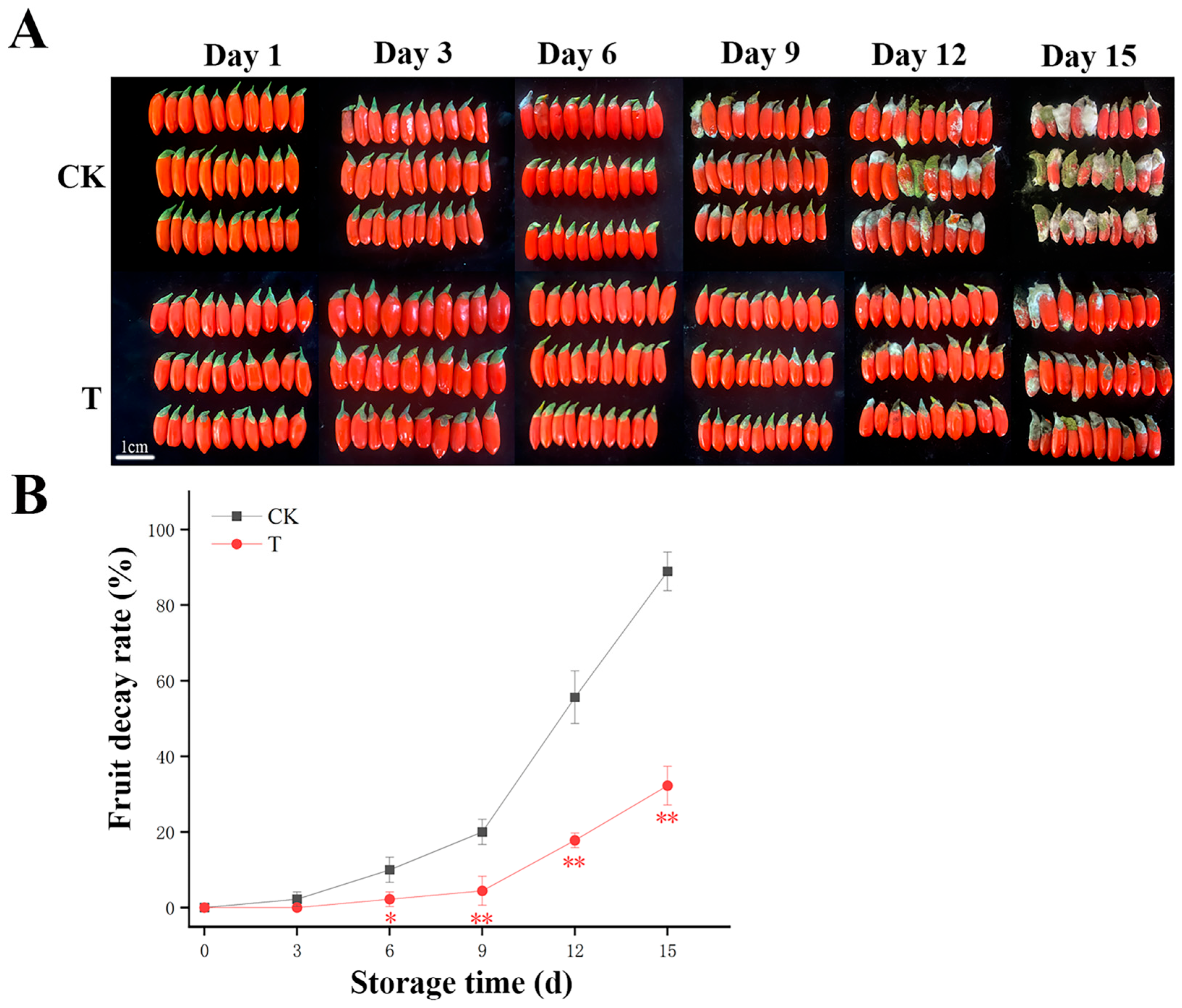


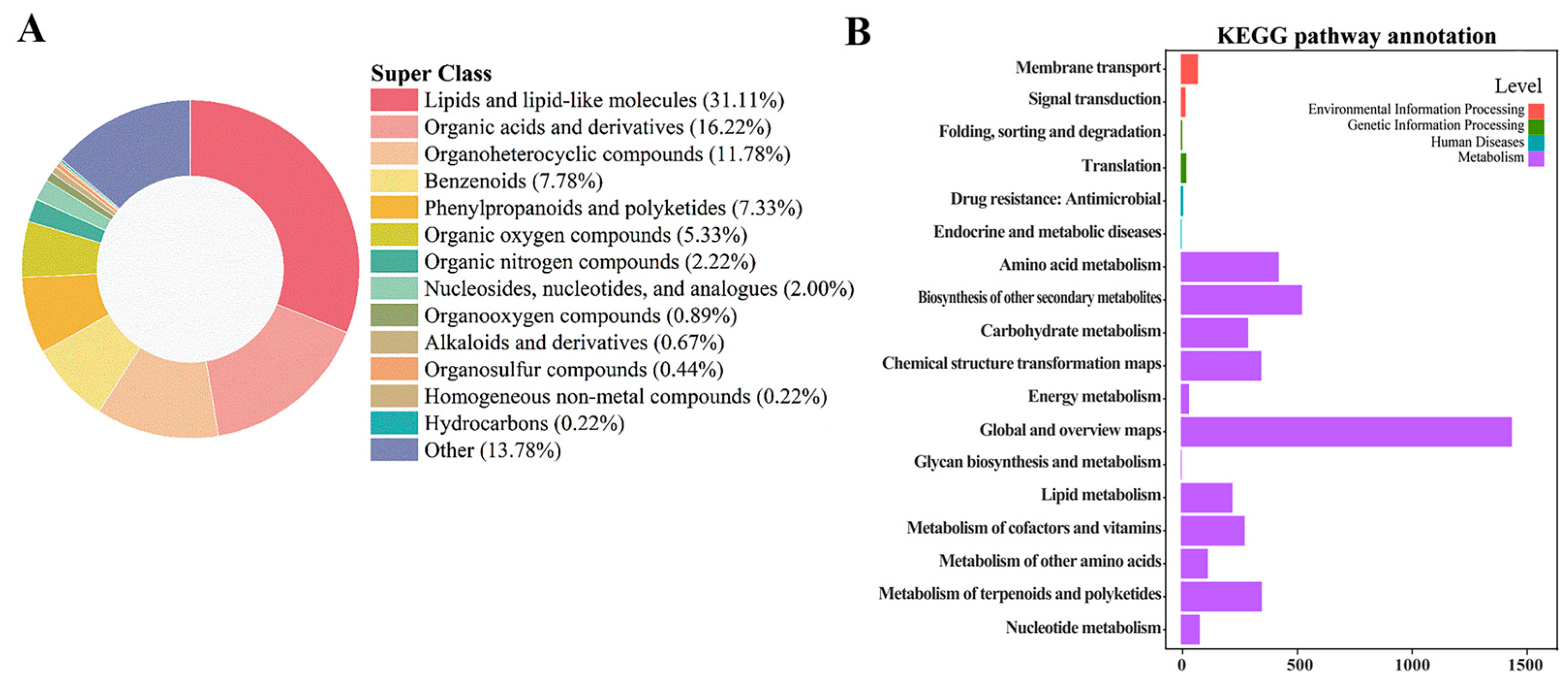
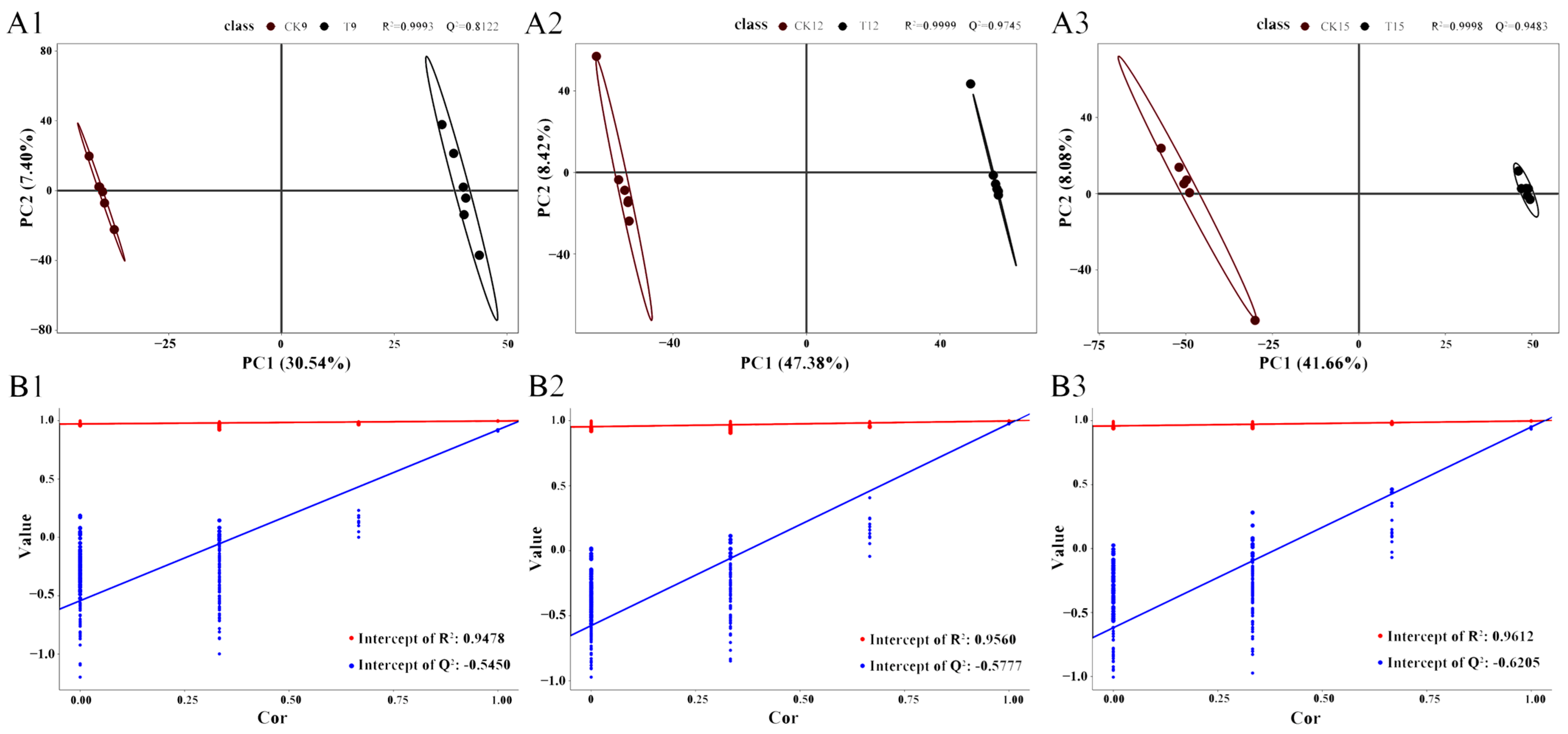


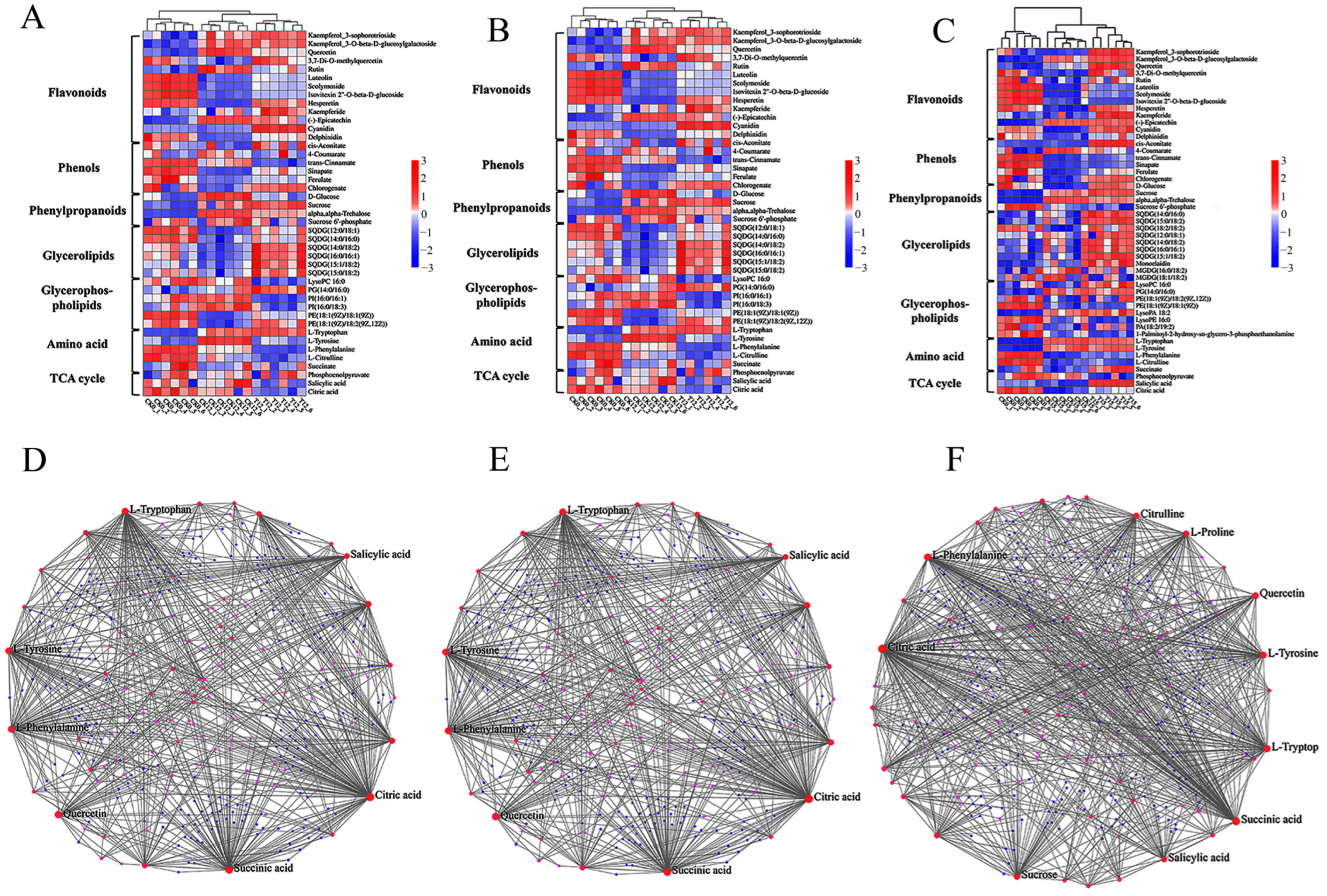

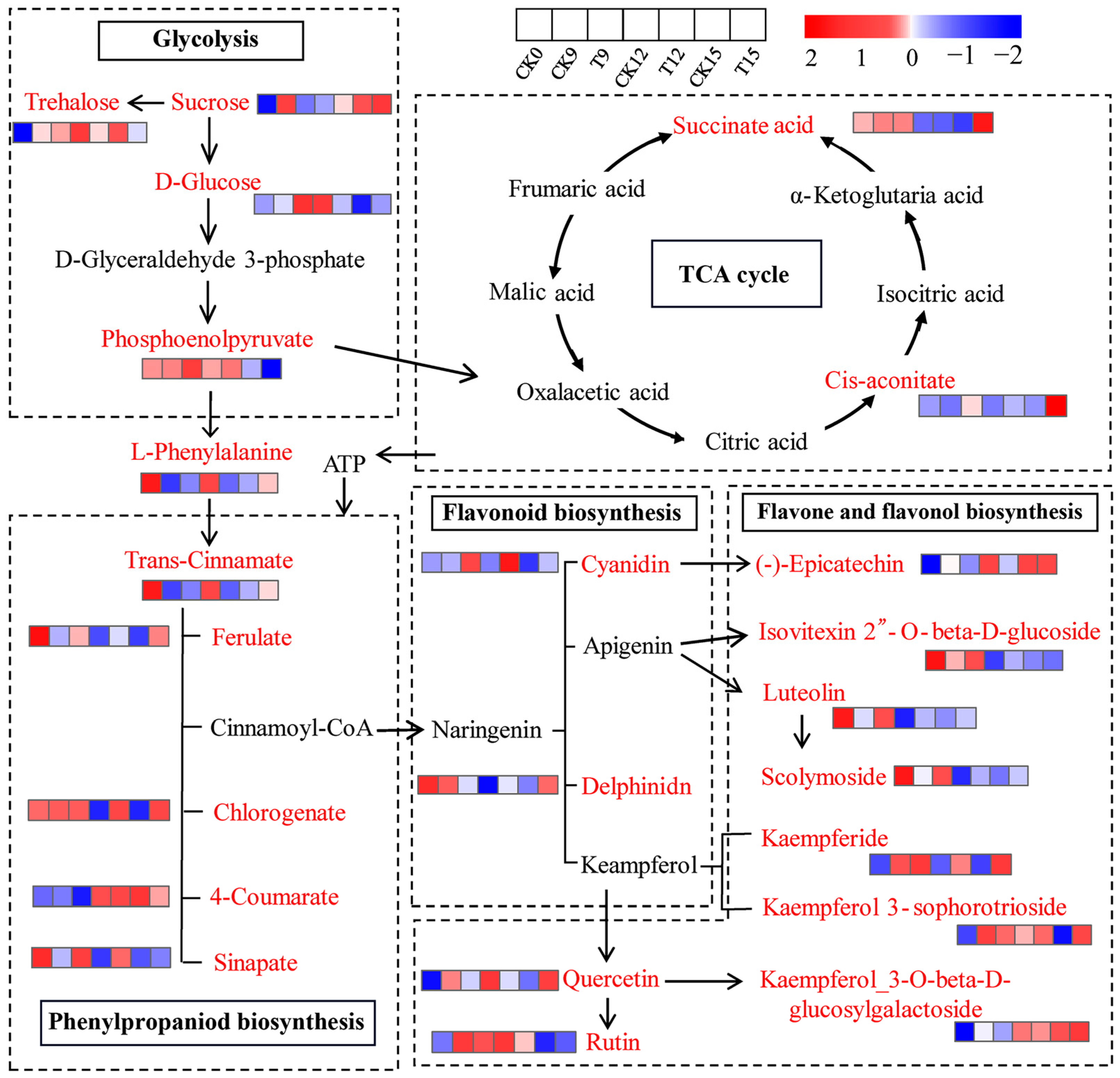
Disclaimer/Publisher’s Note: The statements, opinions and data contained in all publications are solely those of the individual author(s) and contributor(s) and not of MDPI and/or the editor(s). MDPI and/or the editor(s) disclaim responsibility for any injury to people or property resulting from any ideas, methods, instructions or products referred to in the content. |
© 2025 by the authors. Licensee MDPI, Basel, Switzerland. This article is an open access article distributed under the terms and conditions of the Creative Commons Attribution (CC BY) license (https://creativecommons.org/licenses/by/4.0/).
Share and Cite
Wang, Y.-Z.; Du, J.; Ma, W.-P.; Ma, R.-H.; Thakur, K.; Ni, Z.-J.; Wang, W.; Wei, Z.-J. Untargeted Metabolomics Reveals the Effect of Carbon Dots on Improving the Shelf Life of Postharvest Goji Berries (Lycium barbarum L.). Foods 2025, 14, 3336. https://doi.org/10.3390/foods14193336
Wang Y-Z, Du J, Ma W-P, Ma R-H, Thakur K, Ni Z-J, Wang W, Wei Z-J. Untargeted Metabolomics Reveals the Effect of Carbon Dots on Improving the Shelf Life of Postharvest Goji Berries (Lycium barbarum L.). Foods. 2025; 14(19):3336. https://doi.org/10.3390/foods14193336
Chicago/Turabian StyleWang, Yuan-Zhe, Juan Du, Wen-Ping Ma, Run-Hui Ma, Kiran Thakur, Zhi-Jing Ni, Wei Wang, and Zhao-Jun Wei. 2025. "Untargeted Metabolomics Reveals the Effect of Carbon Dots on Improving the Shelf Life of Postharvest Goji Berries (Lycium barbarum L.)" Foods 14, no. 19: 3336. https://doi.org/10.3390/foods14193336
APA StyleWang, Y.-Z., Du, J., Ma, W.-P., Ma, R.-H., Thakur, K., Ni, Z.-J., Wang, W., & Wei, Z.-J. (2025). Untargeted Metabolomics Reveals the Effect of Carbon Dots on Improving the Shelf Life of Postharvest Goji Berries (Lycium barbarum L.). Foods, 14(19), 3336. https://doi.org/10.3390/foods14193336






